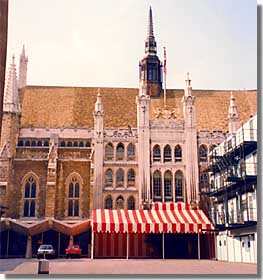
This version of the London Guildhall, the heart of medieval (and present) city administration, was begun in 1411. It was built atop part of the site of the previous guildhall. The grandiose size of the present guildhall – on a par with the huge city halls built in Europe's wealthy cities of Italy, Flanders and elsewhere – is disguised by the relatively confined site on which it had to be built, so that today it is not easily visible because of the surrounding buildings. The ambition to create a seat of municipal government whose majesty reflected the importance of the chief city of England stemmed from both the crystallizing sense of corporate dignity and the individual pride in citizenship of the individual townsmen whose contributions funded the initial phase of construction. The building was largely completed by 1439, the lifetime work of master mason John Croxton. The great hall was second in size only to that of the king's hall at Westminster, and the mayor sat there on a dais to preside over affairs, as the king did in his hall.
We first hear of what seems to be the city guildhall (terra Gialle) ca.1127, while a husting court (the name, of Norse origin, itself implying a building) is known from the late tenth century. The location of the guildhall may itself suggest early importance of the site, for it lies at the meeting-point of three ancient wards, including that of Aldermanbury (now Cripplegate), whose name may reflect an ancient hub of pre-Conquest London: a burh governed by an alderman. Recent excavations suggest that the builders may have taken advantage of surviving remains of a Roman amphitheatre formerly on that site.
A reference to a group of 12 leading citizens in 1087 may represent the aldermen of the London wards (eventually expanding to 26 in number). It is probable that the aldermen would have met in husting to discuss civic affairs, and they later had their own court. The guildhall itself was occasionally used for larger assemblies of citizens to discuss important issues – such as in 1191, when they had to decide which side to back in a struggle for power between William de Longchamp, justiciar of the absent Richard I, and Prince John. However, the ancient folkmoot, which met three times a year, was located in what became part of the churchyard of St. Paul's. Today, the guildhall continues to be used for functions which heark back to fundamentals of borough political life: meetings of the Common Council, the swearing-in of newly-elected mayors, and grants of the freedom.
For further information, see Florilegium Urbanum or the City of London Web site.
